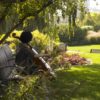One of the most exciting parts of designing a landscape is getting to spend time on site. Whether placing boulders or laying out the space, it’s a treat to be outdoors and interacting with the landscape. Here’s a sneak peak into our process as we begin work on our newest project, Hidden Hollow at the Heritage Museums and Gardens in Sandwich, MA:

Julie directs the boulder placement for the dry waterfall. Photo: Jana Bryan Wunderle.
When our design team visited Heritage Museums and Gardens and first saw the future site of Hidden Hollow, a Nature Discovery Center for children to be certified by the Arbor Day Foundation as a Nature Explore Classroom, we knew immediately that we wanted to be a part of this exciting project. Hidden Hollow is located in a low-lying natural kettle hole carved out by glacial activity and is surrounded by lush rhododendron groves, part of the exquisite Dexter Rhododendron collection housed at Heritage (be sure to check out Heritage’s Rhododenron Festival on June 4). The dream of Hidden Hollow has been three years in the making–a result of the collaborative efforts and vision of Executive Director Scott Swank and Director of Education and Public Programs Heather Mead, along with Heritage’s dedicated Board of Directors. The team researched and established the need for children’s horticultural exploration, selected the site, and expanded their children’s programming under the management of Environmental Education Specialist Tobey Eugenio.

Catch the Rhododendron Festival June 4. Photo: Heritage Museums and Gardens.
The grade change from the Hidden Hollow entrance to the space itself–a uniquely challenging and inspiring feature of this land form- will offer visitors the chance to see the landscape unfold before them as they descend into the space. Excited by the site and its potential, I jumped right in, working with, Larry, the excavator operator for Francisco Tavares, Inc. (the project contractor), to set boulders and create a dry stone waterfall at one end of the Hollow. Meanwhile, the rest of the JMMDS team toured the site and collected more information. Later, back in the studio, we brainstormed ideas and JMMDS designer Anna Johansen created a conceptual plan dividing Hidden Hollow into different activity zones for children, from places where they could crawl and climb, to fort and block-building areas, to musical groves. All of this in preparation for our next site visit, in which we would put some of these ideas to the test by mocking them up full scale in the landscape.

Mocking up boardwalks and paths with marking paint. Photo: Anna Johansen.
When we returned to Hidden Hollow for a follow-up site visit, Anna and I took the day to mock up the conceptual design in the actual landscape. Using marking paint, flagging, and natural materials like log rounds, stones, and sticks, we laid out each part of Hidden Hollow and the paths and boardwalks that would connect each separate space. Mocking up a site in this way is a chance for designers to test the assumptions of their conceptual ideas on site in full scale and make changes accordingly. It’s also helpful for our clients to walk through the space and understand the relationships between elements–after all, not everyone is used to seeing the world in plan view!

Trying out the lines of the mushroom-shaped group gathering area. Photo: Anna Johansen.
Anna compares mocking up a site to testing paint samples on the walls of your home–you try out several colors (or in our case, design configurations) and can then make a more informed decision about the direction in which to take your project. And we encourage you to try a mock-up in your own landscape–here are some pointers to get you started:
DO try this at home: tips to help you mock up your designs
-Start with materials that are easy to move around (like colored tape and small flags) and employ a range of colors to represent different elements (water, plant mass, hardscape, etc.)
-To create curves, use a malleable material like tape, rope or hoses to make the curve you want.
-Once you’ve created the lines you’re looking for, use marking paint to make them more evident so you can live with the shape for a few days before rains wash it away
-Use taller stakes to represent trees and taller focal points to differentiate the vertical structures from the horizontals
-Take advantage of the natural materials around you: use twigs, stones, logs, leaves–anything you can find is a resource
-View and walk your mock-up from different angles and perspectives, including from both inside and outside your home
-Document your process: take plenty of photos to use for later reference
-Give every idea a shot: just try it out and remember that you can always change your design

Half logs and stakes mark the Fairy Ring-inspired learning circle. Photo: Anna Johansen.
More about Heritage Museums and Gardens
Heritage Museums and Gardens is a naturalized woodland park located on historic and picturesque Cape Cod, Massachusetts, on the edge of upper Shawme Pond. Famous for its Dexter Rhododendrons, Heritage Museums and Gardens also house a Shaker-style round barn containing the J. K. Lilly III Antique Automobile Collection, an American History Museum, a hand-carved operating carousel, and a distinguished Art Museum, as well as miles of walking paths. The Hidden Hollow Nature Discovery Center is slated to open this summer, with its full landscape design and installation to be completed later this year.






Wow looking good, I heard about this at a conference in January and my class is scheduled to visit in Sept. Plus I can’t wait to bring my grandaughters when it is finished.
Best of luck
Jeanne,
Thanks for your comment. We’ll be doing an update on this garden after my colleague Anna Johansen, the Heritage staff, and the crew from Francisco Tavares, Inc put the finishing touches on it in the next few weeks. We’re all excited to see it full of children exploring nature!